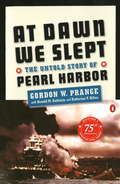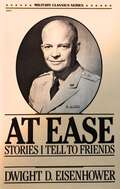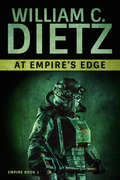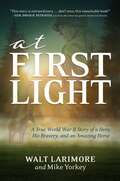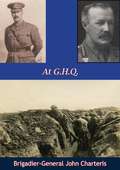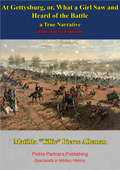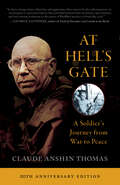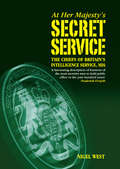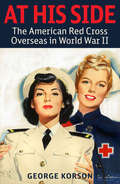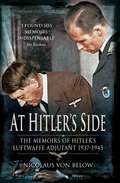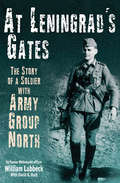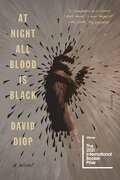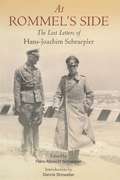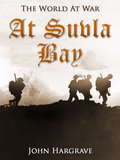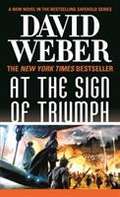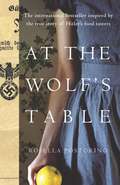- Table View
- List View
At Dawn We Slept: The Untold Story of Pearl Harbor; Revised Edition
by Gordon W. Prange Donald M. Goldstein Katherine V. DillonRevisit the definitive book on Pearl Harbor in advance of the 75th anniversary (December 7, 2016) of the "date which will live in infamy"At 7:53 a.m., December 7, 1941, America's national consciousness and confidence were rocked as the first wave of Japanese warplanes took aim at the U.S. Naval fleet stationed at Pearl Harbor. As intense and absorbing as a suspense novel, At Dawn We Slept is the unparalleled and exhaustive account of the Japanese bombing of Pearl Harbor. It is widely regarded as the definitive assessment of the events surrounding one of the most daring and brilliant naval operations of all time. Through extensive research and interviews with American and Japanese leaders, Gordon W. Prange has written a remarkable historical account of the assault that-sixty years later-America cannot forget."The reader is bound to feel its power....It is impossible to forget such an account." —The New York Times Book Review"At Dawn We Slept is the definitive account of Pearl Harbor." —Chicago Sun-TimesFrom the Trade Paperback edition.
At Ease: Stories I Tell to Friends
by Dwight D. EisenhowerPresident Eisenhower here tells a number of stories for the simple pleasure of telling them. In warm and personal terms, he writes about his life, his acquaintances both celebrated and little known, and the history that unfolded before his eyes. In anecdote after anecdote, we learn about life at West Point, in turn-of-the-century Kansas, in an "ordinary" but remarkable family. His storytelling suggests what it was like to grow up and go to school at a time when the wild west had just become the rural west, when the frontier was his home town. It awakened the dreams of adventure in a boy's imagination--and carried him from the wrong side of the tracks in Abilene to the leadership of a great alliance and military expedition, a great university, and a great nation. The young Eisenhower's dreams, he thought, could probably best be realized at Annapolis. And yet--through a fortuitous turn or events--the future naval officer settled in at West Point. From the Point to the Presidency is a chronicle that now belongs to history, and the author has done his duty in Crusade in Europe, Mandate for Change and Waging Peace (THE WHITE HOUSE YEARS). This new book is written for fun--as he remembers his tour of duty in the Canal Zone, life with his young wife Mamie, and how, on patrol in tropical terrain, he was tutored in Clausewitz, Tacitus, and Plato by his mentor, a little known and wonderful general named Fox Conner. He recalls his first encounter with a spirited colonel, George Patton, and his appointment, later, as aide to the already controversial general, Douglas MacArthur. Roosevelt, Churchill, Zhukov, Marshall, Bradley, SHAPE, TORCH, Columbia, NATO--the men and events and institutions that have become household words are touched upon here and newly illumined, as are the lesser known people and places in a peaceful man's peacetime existence. Up to the moment he returns to the United States to run for the Presidency, we are given--as friends--stories written by a President at ease and rendered with all the sincerity, geniality, conviction, and persuasiveness the entire world has come to know.
At Empire's Edge (Empire #1)
by William C. DietzThe national bestselling author of Battle Hymn delivers a high-velocity sci-fi thriller in which a lone lawman must take down those who would topple an empire…For centuries, the Uman Empire has ruled the civilized universe. But not all of the alien races who were “invited” to join the Empire have done so willingly. To deal with these alien species, the Xeno Corps was formed—bio-engineered humans with extra-sensory enhancements who can hunt down, capture or eliminate all such threats to Pax Umana.Jak Cato is a one of them—but he’s far from a perfect specimen. Saddled with a dislike for authority and a penchant for self-destructive behavior, only his devotion to duty and sense of honor have kept him afloat in the Corps.When he and his comrades are waylaid on a remote planet while transferring a lethal, shapeshifting Sagathi prisoner, Cato is sent into town for supplies, only to end up drunk, beaten and robbed. But worse news awaits him when he wakes. His entire detachment has been mercilessly slaughtered and the Sagathi is gone.Now Cato must use all his innate skills to hunt down the fugitive and pay back the bastards who murdered his team. But what he doesn’t know is that his pursuit will lead him outside the law and into a shadowy world of Imperial intrigue—where those who seek justice rarely get it, and rarely survive…“A testosterone-soaked tale of violent retribution.”—Publishers Weekly"Dietz writes fast-paced military SF.”—Library Journal
At First Light: A True World War II Story of a Hero, His Bravery, and an Amazing Horse
by Mike Yorkey Walt LarimoreWhat makes 2nd Lieutenant Phil Larimore&’s story special is what happened in World War II&’s closing days and the people—and horses—he interacted with in this Forrest Gump-like tale that is emotional, heartbreaking, and inspiring.Growing up in the 1930s in Memphis, Tennessee, Phil Larimore is the ultimate Boy Scout—able to read maps, put a compass to good use, and traverse wild swamps and desolate canyons. His other great skill is riding horses. Phil does poorly in school, however, leading his parents send to him to a military academy. After Pearl Harbor, Phil realizes he is destined for war. Three weeks before his eighteenth birthday, he becomes the youngest candidate to ever graduate from Officer Candidate School (OCS) at Fort Benning, Georgia. Landing on the Anzio beachhead in February 1944, Phil is put in charge of an Ammunition Pioneer Platoon in the 3rd Infantry Division. Their job: deliver ammunition to the frontline foxholes—a dangerous assignment involving regular forays into No Man&’s Land. As Phil fights his way up the Italian boot, into Southern France and across the Rhine River into Germany, he is caught up in some of the most intense combat ever. But it&’s what happens in the final stages of the war and his homecoming that makes Phil&’s story incredibly special and heartwarming. An emotional tale of courage, daring, and heroism, At First Light will remind you of the indomitable human spirit that lives in all of us.
At First Touch
by Cindy MilesDon't trust your eyes. Trust your heart... After suffering a tragic accident, Reagan Quinn has her military career cut short and her sight gone forever. Returning to her childhood home only reminds Reagan of what she's lost. No light, no color-just shadows and indistinct forms. But one man refuses to let her give up on herself. Reagan can't see Eric Malone. All she knows is that he's there every day, driving her completely bonkers. Eric pushes her out of the darkness and into a world shaped by taste, touch and scent. But Reagan isn't quite prepared for what happens when she stops depending on her sight...and starts seeing with her heart.
At G.H.Q.
by Brigadier-General John CharterisArguably the most personal of the major British command memoirs of WWI, covering the full duration of the conflict. Charteris was Haig's BGGS (Intelligence) from 1916 to 1918; his nickname 'The Principal Boy' derives from his early promotion (Brigadier-General at 38) and his perceived influence upon Haig himself.“All of us who served through those four eventful years from August 1914 onwards, have stored in our memories recollections that we treasure. We can hardly expect that any of the years still remaining to us will rival in interest that period of our lives.Many may have had the good fortune which was mine, that every scrap of writing sent home from the front was carefully preserved. Others also may have sought to frame from these letters for the benefit of their own families, some readable and coherent record of their doings and their thoughts in the years of crisis and strain. Such was my intention when I began the writing which has now developed into this volume. For, as I wrote, I found it necessary to refer to the records which I myself had of my work at G.H.Q. I had not kept a formal diary; but very early in my days at G.H.Q., I found it necessary to keep notes of my views from day to day, and in particular of the conversations which I had with many people in high places. A most careful and painstaking secretary had seen to it that all the letters which I received and wrote, other than those to my own home, were carefully filed.From these records I have compiled this volume. It is published in the hope that it will serve to give some idea of the life and problems of G.H.Q., and perhaps throw some light on events that are still obscure.”—Brig.-Gen. John Charteris
At Gettysburg, Or, What A Girl Saw And Heard Of The Battle. A True Narrative. [Illustrated Edition]
by Matilda "Tillie" Pierce AllemanIncludes Gettysburg Map and Illustrations Pack - 30 additional maps, plans and illustrations"The experience of a little girl, during three days of a hard fought battle, as portrayed in this volume is certainly of rare occurrence, and very likely has never been realized before.Such a narrative as the following, is worthy of preservation among the pages of our nations literature.The story is told with such marked faithfulness, such honesty of expression, such vividness of portrayal, that those who lived in, and passed through those scenes, or similar ones, will at once recognize the situations, and surroundings, as natural and real.While perusing its pages, the veteran will again live in the days gone by; when he tramped the dusty march, joined in the terrible charge, or suffered in the army hospital.The Heroine of this book, performed her part well; but it is doubtful whether, at the time, she fully realized the heart-felt thanks, and noble thoughts that sprang from the "Boys in Blue," in response to her heroism and kindness.How vividly is presented the weary march to the field of conflict; our eagerness to quaff the sparkling water, as she handed it to us, fresh from the cooling spring.We thanked her, but she did not hear the full gratitude that was in our hearts."-Preface.
At Hell's Gate: A Soldier's Journey from War to Peace
by Claude Anshin ThomasIn this raw and moving memoir, Claude Thomas describes his service in Vietnam, his subsequent emotional collapse, and his remarkable journey toward healing. At Hell's Gate is not only a gripping coming-of-age story but a spiritual travelogue from the horrors of combat to the discovery of inner peace—a journey that inspired Thomas to become a Zen monk and peace activist who travels to war-scarred regions around the world. "Everyone has their Vietnam," Thomas writes. "Everyone has their own experience of violence, calamity, or trauma." With simplicity and power, this book offers timeless teachings on how we can all find healing, and it presents practical guidance on how mindfulness and compassion can transform our lives. This expanded paperback edition features: • Discussion questions for reading groups • A new afterword by the author reflecting on how the current wars in Iraq and Afghanistan are affecting soldiers—and offering advice on how to help returning soldiers to cope with their combat experiences
At Her Majestys Secret Service: The Chiefs of Britains Intelligence Service, MI6
by Nigel WestIn August 1909, a kindly, balding, figure named Mansfield Smith-Cumming was summoned to London by Admiral Alexander Bethell, Director of Naval Intelligence. He was to assume the inaugural position of Chief – more famously known as ‘C – of what has become
At His Side: The Story of the American Red Cross Overseas in World War II
by George Gershon KorsonAt His Side, first published in 1945, is the authoritative work on the many important overseas activities of the American Red Cross during the Second World War. From field hospitals, nursing, blood collection, entertainment, to simply providing coffee and fresh doughnuts to exhausted troops, the dedicated workers of the Red Cross were there to save lives and boost morale. The book includes personal accounts of many Red Cross workers involved in all aspects of the Red Cross' overseas wartime efforts, and from all regions of the globe—reports from India, China, North Africa, Guadalcanal, the Philippines, Europe, Australia, Iceland, and more, are presented in a highly readable fashion. Included are 17 maps of the various theaters where the Red Cross operated.
At Hitler's Side: The Memoirs of Hitler's Luftwaffe Adjutant 1937–1945 (Greenhill Military Paperbacks)
by Nicolaus von Below&“An intimate glimpse into the decision-making process of the Nazi military leadership&” from a Luftwaffe aide at Hitler&’s side until the last days in Berlin (Library Journal). Nicolaus von Below was a 29-year-old pilot when Goering selected him for the position of Hitler&’s Luftwaffe adjutant. He was with Hitler at every stage as the Second World War unfolded. His observations tell of Hitler&’s responses to momentous events as well as military decisions and policy-making at headquarters. Published for the first time in English, this is a superb historical source describing life in Hitler&’s inner circle, relied upon by Gitta Sereny in her biography of Albert Speer. The book provides fascinating insight into how Hitler planned the invasions of Poland and Russia; what he thought of Britain and America; why he placed his faith in the V-1 and V-2 projects; how others dealt with him; and much more. Von Below was present at the assassination attempt in July 1944, and records the effect on Hitler and his followers. He was also the last of Hitler&’s close military entourage to emerge from the bunker alive, eventually imprisoned as a material witness at Nuremberg. &“Sure to become an important memoir for those studying the Nazi war machine.&”—Publishers Weekly &“Indispensable.&”—Ian Kershaw, author of Hitler: A Biography
At Last She Stood: How Joey Guerrero Spied, Survived, and Fought for Freedom
by Erin Entrada Kelly"A courageous, uplifting biography of a woman almost lost to history.” –ALA Booklist World War II spy, Filipino guerrilla fighter, war hero, Medal of Freedom recipient, leprosy survivor, teacher, peacemaker . . . The legendary and inspiring life and work of Josefina “Joey” Guerrero is introduced to readers by two-time Newbery Medal winner, National Book Award finalist, and bestselling author Erin Entrada Kelly. For fans of Steve Sheinkin and Candace Fleming.Joey Guerrero, a native of the Philippines, was diagnosed with leprosy (Hansen’s disease) as World War II unfolded in Europe and Asia. Soon after the Japanese occupied the Philippines, Joey—believing she would die soon—joined the guerrilla movement to complete covert missions in support of the Allies. Because of her condition, she was rarely searched by Japanese soldiers, which allowed her to courier secret messages, including an invaluable minefield map that she taped to her back. She was eventually awarded the US Presidential Medal of Freedom and admitted to the National Leprosarium in Carville, Louisiana, where she lived for nine years. When she was cured and released, she found it difficult to find work because of racial discrimination and her health history and was forced to pawn her Presidential Medal to make ends meet. Eventually, she shed her previous identity. When she died in 1996, her obituary identified her as a secretary from Manila. But Joey Guerrero was much more than that—she was a hero who changed the course of history.Erin Entrada Kelly’s engaging nonfiction debut combines themes of the Philippines, World War II, the Asia-Pacific War, spy stories, Louisiana, immigration, disease and medicine, racism, perseverance, religious devotion, and hope. Illustrated with photographs, maps, and other illustrative material and featuring sidebars that clearly illuminate key moments in history, At Last She Stood is for readers and educators who love Candace Fleming, Deborah Heiligman, Christina Soontornvat, and Steve Sheinkin. Includes an author’s note, source notes, index, and other back matter.
At Leningrad's Gates: The Combat Memoirs of a Soldier with Army Group North
by William Lubbeck<p>“A first-rate memoir” from a German soldier who rose from conscript private to captain of a heavy weapons company on the Eastern Front of World War II (City Book Review).<p> <p>William Lubbeck, age nineteen, was drafted into the Wehrmacht in August 1939. As a member of the 58th Infantry Division, he received his baptism of fire during the 1940 invasion of France. The following spring, his division served on the left flank of Army Group North in Operation Barbarossa. After grueling marches amid countless Russian bodies, burnt-out vehicles, and a great number of cheering Baltic civilians, Lubbeck’s unit entered the outskirts of Leningrad, making the deepest penetration of any German formation.<p> <p>In September 1943, Lubbeck earned the Iron Cross First Class and was assigned to officers’ training school in Dresden. By the time he returned to Russia, Army Group North was in full-scale retreat. In the last chaotic scramble from East Prussia, Lubbeck was able to evacuate on a newly minted German destroyer. He recounts how the ship arrived in the British zone off Denmark with all guns blazing against pursuing Russians. The following morning, May 8, 1945, he learned that the war was over.<p> <p>After his release from British captivity, Lubbeck married his sweetheart, Anneliese, and in 1949, immigrated to the United States where he raised a successful family. With the assistance of David B. Hurt, he has drawn on his wartime notes and letters, Soldatbuch, regimental history, and personal memories to recount his four years of frontline experience. Containing rare firsthand accounts of both triumph and disaster, At Leningrad’s Gates provides a fascinating glimpse into the reality of combat on the Eastern Front.<p>
At Night All Blood Is Black: A Novel
by David DiopSelected by students across France to win the Prix Goncourt des Lycéens, David Diop’s English-language, historical fiction debut At Night All Blood is Black is a “powerful, hypnotic, and dark novel” (Livres Hebdo) of terror and transformation in the trenches of the First World War. <p><p> Alfa Ndiaye is a Senegalese man who, never before having left his village, finds himself fighting as a so-called “Chocolat” soldier with the French army during World War I. When his friend Mademba Diop, in the same regiment, is seriously injured in battle, Diop begs Alfa to kill him and spare him the pain of a long and agonizing death in No Man’s Land. <p><p> Unable to commit this mercy killing, madness creeps into Alfa’s mind as he comes to see this refusal as a cruel moment of cowardice. Anxious to avenge the death of his friend and find forgiveness for himself, he begins a macabre ritual: every night he sneaks across enemy lines to find and murder a blue-eyed German soldier, and every night he returns to base, unharmed, with the German’s severed hand. At first his comrades look at Alfa’s deeds with admiration, but soon rumors begin to circulate that this super soldier isn’t a hero, but a sorcerer, a soul-eater. Plans are hatched to get Alfa away from the front, and to separate him from his growing collection of hands, but how does one reason with a demon, and how far will Alfa go to make amends to his dead friend? <p><p> Peppered with bullets and black magic, this remarkable novel fills in a forgotten chapter in the history of World War I. Blending oral storytelling traditions with the gritty, day-to-day, journalistic horror of life in the trenches, David Diop's At Night All Blood is Black is a dazzling tale of a man’s descent into madness.
At Rommel's Side: The Lost Letters of Hans-Joachim Schraepler
by Hans-Joachim SchraeplerErwin Rommel, Hitler's so-called 'Desert Fox', is possibly the most famous German Field-Marshal of WWII. He is widely regarded as the one of the most skilled commanders of desert warfare and, in contrast to other leaders of Nazi Germany, is considered to have been a chivalrous and humane officer. The letters of his adjutant provide a unique picture of Rommel during his time in Libya. Hans-Joachim Schraepler was by Rommel's side in North Africa for ten crucial months in 1940-41. During that time, he wrote to his wife almost every day. In most cases, the correspondence went via the usual channels but occasionally he used other methods to avoid the censor's gaze.Through his letters, Schraepler supplies a vivid image of the first phase of the North Africa campaign. He covers the siege of Tobruk, the capture of Benghazi, and the difficulties experienced by those fighting in Cyrenica and the wider North African theatre. He also complains that the Italian were poor Allies, lacking training and leadership, and that Berlin regarded North Africa as a theatre of only secondary importance.Schraepler also provides insights into Rommel's character—his dynamism and tactical skill, along with the growing 'cult of personality' which seemed to surround him. One of his unofficial tasks, for example, was to respond in Rommel's name to much of the fan mail that arrived at the Afrikakorps HQ.Hans-Albrecht Schraepler was only seven years old when his father died. The cache of letters was held by his mother and remained untouched for sixty years. His father's last letter, found the day of his death, remains unfinished.
At Some Disputed Barricade: 1917 (World War One #4)
by Anne PerryAnne Perry's gift for illuminating the heart's deepest secrets shines through in her bestselling series of World War I novels. With compelling immediacy, she depicts the struggles of men and women torn by their convictions and challenged by the perils of war. July 1917. Joseph Reavley, a chaplain, and his sister, Judith, an ambulance driver, are bone-weary as they approach the fourth year of the conflict; the peace of the English countryside seems a world away. On the Western Front, the Battle of Passchendaele has begun, and among the many fatalities from Joseph's regiment is the trusted commanding officer, who is replaced by a young major whose pompous incompetence virtually guarantees that many good soldiers will die needlessly. But soon he, too, is dead-killed by his own men. Although Joseph would like to turn a blind eye, he knows that he must not. Judith, however, anguished at the prospect of courts-martial and executions for the twelve men arrested for the crime, has no such inhibitions and, risking of her own life, helps all but one of the prisoners to escape. Back in England, Joseph and Judith's brother, Matthew, continues his desperate pursuit to unmask the sinister figure known as the Peacemaker-an obsessed genius who has committed murder and treason in an attempt to stop Britain from winning the war. As Matthew trails the Peacemaker, Joseph tracks his comrades through Switzerland and into enemy territory. His search will lead to a reckoning pitting courage and honor against the blind machinery of military justice. At Some Disputed Barricadeis an Anne Perry masterpiece-brilliant, surprising, and unforgettable. From the Hardcover edition.
At Summer's End
by Courtney Ellis"A sparkling debut from a new author we&’re all going to want more from.&”—Susan Meissner, bestselling author of The Nature of Fragile Things When an ambitious female artist accepts an unexpected commission at a powerful earl's country estate in 1920s England, she finds his war-torn family crumbling under the weight of long-kept secrets. From debut author Courtney Ellis comes a captivating novel about finding the courage to heal after the ravages of war. Alberta Preston accepts the commission of a lifetime when she receives an invitation from the Earl of Wakeford to spend a summer painting at His Lordship's country home, Castle Braemore. Bertie imagines her residence at the prodigious estate will finally enable her to embark on a professional career and prove her worth as an artist, regardless of her gender. Upon her arrival, however, Bertie finds the opulent Braemore and its inhabitants diminished by the Great War. The earl has been living in isolation since returning from the trenches, locked away in his rooms and hiding battle scars behind a prosthetic mask. While his younger siblings eagerly welcome Bertie into their world, she soon sees chips in that world's gilded facade. As she and the earl develop an unexpected bond, Bertie becomes deeply entangled in the pain and secrets she discovers hidden within Castle Braemore and the hearts of its residents. Threaded with hope, love, and loss, At Summer's End delivers a portrait of a noble family--and a world--changed forever by the war to end all wars.
At Suvla Bay: Being The Notes And Sketches Of Scenes, Characters And Adventures Of The Dardanelles Campaign - Primary Source Edition (The World At War)
by John HargraveJohn Gordon Hargrave (6 June 1894 - 21 November 1982), (woodcraft name 'White Fox'), was described in his obituary as an 'author, cartoonist, inventor, lexicographer, artist and psychic healer'. As Head Man of the Kibbo Kift, he was a prominent youth leader in Britain during the 1920s and 1930s. He was a Utopian thinker, a believer in both science and magic, and a figure-head for the Social Credit movement in British politics. "At Suvla Bay"; Being the notes and sketches of scenes, characters and adventures of the Dardanelles campaign. (Excerpt from Wikipedia)
At The Front
by Lieutenant Alec JohnstonTHE purpose of this little volume is to preserve, for his friends and the many others who cared for his writings, a record of the work which Alec Johnston contributed to Punch during the War. Written under all sorts of impossible conditions, they never pretended to be more than the gay and cynical banter of one who brought to the hardships and perils of life at the Front an incurable habit of humour. For several years Alec Johnston had been associated with Punch as an occasional contributor of light verse and prose. After leaving Oxford where, as at St. Paul's School, he had given promise of a brilliant career, he became a schoolmaster, but his inclinations lay elsewhere and he would probably have followed the profession of letters but for the outbreak of war. Within two days he enlisted in the Artists' Rifles-he was then twenty-five years old-and went out with their first draft in October, 1914. In February of the next year he received a commission in the 1st King's Shropshire Light Infantry, and was with them first at Armentières, and then upon the Ypres salient till his death. He was promoted Lieutenant in September, 1915.
At The Front In A Flivver [Illustrated Edition]
by William Yorke StevensonMany American citizens flocked to join the Allied war effort against Germany during the First World War before their mother country eventually declared war in 1917. William Yorke Stevenson was one of their number, volunteering for service with the French Ambulance corps or Section Sanitaire. Never war from the frontlines in rather ramshackle old vehicles [the flivver of the title is a slang term for a run-down truck], these men risked their lives to evacuate and treat the wounded.The Author recounts his experiences of 1915-1917 based on his dairy of the period. It provides a day-by-day account of the medical services behind the lines during some of the heaviest French fighting of the war during the battle of the Somme. Illustrated throughout with the Author's own photos of the period, including his comrades, conditions and the battle damage of the towns and villages amongst which he worked and lived.Author -- William Yorke Stevenson (1878 - 1922)Text taken, whole and complete, from the edition published in Boston and New York, Houghton Miflin, 1917.Original Page Count - 334 pages.Illustrations -- 12 illustrations.
At The Sign Of Triumph (Safehold Series #9)
by David WeberThe Church of God Awaiting's triumph over Charis was inevitable. Despite its prosperity, the Charis was a single, small island realm. It boasted less than two percent of the total population of Safehold. How could it possibly resist total destruction? The Church had every reason to be confident of a swift, crushing victory, an object lesson to other rebels. But Charis had something far more powerful than simple numbers. It had a king, a crown prince, and a navy prepared to die where they stood in its defense. It had the Brethren of Saint Zherneau, who knew the truth about Safehold's founding. Who knew that the Church of God Awaiting was a monstrous lie. And it had Merlin Athrawes, last survivor of long-vanished Earth. Merlin, the cybernetic avatar of a woman dead over a thousand years, who was determined to break the Church's grip upon the human mind and soul. So after eight years of war, it is not Charis but the Church that stands upon the brink of defeat. But the Church still commands immense resources, and — faced with the unthinkable — it’s decided that it, too, must embrace the forbidden technology which has carried Charis so far. In the end, it is simple, for only one can survive. The lines are drawn, the navies and armies have been raised, and all of Safehold is poised for the final battle between those who believe in freedom and those who would crush it forever.
At The Wolf's Table: A Novel
by Rosella PostorinoThe international bestseller based on the shocking true story of the women conscripted to risk their lives as Hitler’s food tasters'They called it the Wolfsschanze, the Wolf’s Lair. 'Wolf' was his nickname. As hapless as Little Red Riding Hood, I had ended up in his belly. A legion of hunters was out looking for him, and to get him in their grips they would gladly slay me as well.'Germany, 1943: Twenty-six-year-old Rosa Sauer’s parents are gone, and her husband Gregor is far away, fighting on the front lines. Alone, she has little choice but to leave war-torn Berlin behind and live with her in-laws in a village near the Wolfschanze, the Wolf’s Lair, Hitler’s hidden headquarters. Convinced that the enemy wants to poison him, Hitler conscripts ten women, including Rosa, to be his food tasters. Even though food is a luxury, eating the rich and decadent feasts Hitler will soon be served is an act of torture - after each meal, the women must wait an hour to see if they will die. Every minute seems like an eternity. None of the women are allowed to meet Hitler, none can enter the Wolfschanze, but the Führer is a constant presence. He is in every conversation, in Rosa's thoughts, and forever on the radio. He looms large above them all, like some kind of deity. As the war outside goes from bad to worse, so do the lives of the ten women trapped in the tasting room, forced to eat what may kill them. Rosa's friends are keeping explosive secrets, the vindictive SS officer put in charge of the tasters takes a special liking to her, and Rosa must figure out how she can stay alive as it becomes clear that she and her friends, her Hitler, everyone she knows, are on the wrong side of history.
At War With The Wind: The Epic Struggle With Japan's World War II Suicide Bombers
by David SearsDrawing from hundreds of interviews with WWII veterans who survived Japan&’s terrifying kamikaze strikes, acclaimed author and former U.S. Navy Officer David Sears vividly portrays what it was like to experience this tactic, capturing the real-life dramas behind America&’s first confrontation with the psychology and devastating impact of suicide warfare. In the last days of World War II, a new and baffling weapon terrorized the United States Navy in the Pacific. To the sailors who learned to fear them, the body-crashing warriors of Japan were known as &“suiciders&”; among the Japanese, they were named for a divine wind that once saved the home islands from invasion: Told from the perspective of the men who endured this horrifying tactic, At War with the Wind is the first book to recount in nail-biting detail what it was like to experience an attack by Japanese kamikazes. Acclaimed author David Sears draws on personal interviews and unprecedented research to create a narrative of war that is stunning in its vividness and unforgettable in its revelations. This is the candid story of a war within a war—a relentless series of furious and violent engagements pitting men determined to die against men determined to live. Its echoes resonate hauntingly at a time of global conflict, especially when suicide as a weapon remains a perplexing and terrifying reality.Main Selection of the Military Book Club Featured Alternate of the History Book Club
At War at Sea: Sailors and Naval Combat in the Twentieth Century
by Ronald H. SpectorBeginning with a gripping account of one of the most decisive naval battles in history-the 1905 battle of Tsushima between the Japanese and Russians-and ending with the sophisticated missile engagements of the Falklands and in the Persian Gulf, naval historian Ronald Spector explores every facet of the past one hundred years of naval warfare. Drawing from more than one hundred diaries, memoirs, letters, and interviews, this is, above all, a masterful narrative of the human side of combat at sea-real stories told from the point of view of the sailors who experienced it. Exhaustively researched and fascinating in detail, At War at Sea is a monumental history of the men, the ships, and the battles fought on the high seas.
At War in Distant Waters
by Phillip G. PatteeA Great and Urgent Imperial Service investigates the reasons behind Great Britain's combined military and naval offensive expeditions of Europe during the Great War. These campaigns have been branded by various historians as unnecessary sideshows to the conflict waged on the European continent. Pattee argues that the various campaigns were necessary adjuncts to the war in Europe, and fulfilled an important strategic purpose by protecting British trade where it was most vulnerable. Since international trade was essential for maintaining the island nation's way of life, Great Britain required freedom of the seas in order to maintain its global trade. While the German High Seas Fleet constituted a serious threat that placed the British coast at grave risk, forcing the Royal Navy to concentrate in home waters, the importance of the island empire's global trade made it a valuable and vulnerable target to Germany's various commerce raiders-as Admiral Tirpitz's risk theory had anticipated.
